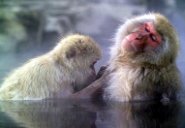The Japanese Macaque - Hot Springs-Loving Similian
 The Japanese macaque (Macaca fuscata), which is also known as the snow monkey, is famous throughout the world for its love of soaking in hot springs on cold winter days. This very human-like behavior has endeared them to those who have seen images of the little monkeys, their fur covered in snow, peeping out from the steaming water.
The Japanese macaque (Macaca fuscata), which is also known as the snow monkey, is famous throughout the world for its love of soaking in hot springs on cold winter days. This very human-like behavior has endeared them to those who have seen images of the little monkeys, their fur covered in snow, peeping out from the steaming water.Japanese macaques have a naked, red to pinkish face. Its fur ranges in color from brown to gray, and it has a short, approximately three-inch tail. In the winter, the macaques that live in the colder regions grow a thick winter coat. On average, Japanese macaques weigh approximately 18 to 24 pounds (11 kg to 8 kg) and are about 20 to 22 inches (522 to 570 mm) in length. Male Japanese macaques are typically slightly larger than females.
The Japanese macaque can be found on three of Japan's four main islands. The only island they do not live on is the northernmost, Hokkaido. The Japanese macaque lives in a wide range of habitats, from lowlands to mountains to by the ocean. Populations can be found on Shimokita Peninsula on Honshu Island, the Nagano Mountains, by the ocean on Oshima Island, and on the southern island of Yaku-Shima. It is the only monkey that lives as far north of the equator as it does.
These monkeys are omnivores. Their diet typically consists of fruit, leaves and insects. They have also been known to consume crabs, fish and eggs. In northern areas, where the winters can be harsh, the Japanese macaque will feed on bark. Some macaques will wash their food in salt water to both clean and flavor it.
The Japanese macaque are highly sociable animals. They live in troops that are typically made up of about 30 to 40 monkeys, though larger groups have been known to exist. Though these troops do have a dominant male, other male monkeys are allowed to stay in the troops. Female macaques also have a pecking order, with offspring of high-ranking females typically enjoying a high rank in the troop, as well.
The macaque’s now famous habit of soaking in hot springs was first noted in 1963 when one monkey in the Nagano Mountain region ventured into the springs to retrieve an item. Soon, other monkeys followed suit. Nowadays, it is a common practice for the troops in this region to soak in the hot springs. Macaque babies in this region have also been seen creating and playing with snowballs.
Predators of the Japanese macaque include dogs, mountain hawk eagles and humans. Unfortunately, the Japanese macaque is not a shy animal and troops have been known to raid crops on farms and snatch food from children and others. Though they enjoy a protected status, they are occasionally killed by humans angered by their behavior. Loss of habitat has also led to a decline in the Japanese macaque’s population. The Japanese macaque is listed on CITES’s Appendix II, meaning that its trade is monitored and its conservation status is listed as of Least Concern by IUCN.
Tags used in this posting
Other entries about 'asia'
- Nilgai -- The Horse-like, Camel-like Antelope
- Javan langur -- The Monkey With a Mane
- Doria's tree-kangaroo
- Douc Langur - Endangered Colorful Asian Monkey
- Banded Hare-wallaby - Endangered Marsupial Nearly Wiped Out By Cats
- European Snow Vole - Vole with the Smallest Litters
- The Northern Chinese Flying Squirrel - The Squirrel with the Medicinal Dung
- White-throated Rock-thrush - the Little Snail-Cracker
- Daurian Hedgehog - Rare Russian Hedgehog Almost Wiped Out By Pesticides
- Greater Mouse Deer - Gives Peek at What Extinct Animals Were Like
- Kulan - Last Wild Donkey that Refuses to be Tamed
- The Lion-Tailed Macaque - A Crying Old Man
- The Tibetan Fox - Silent Stalker of the Steppes
- Tiger - Largest cat killed by Chinese medicine?
- Puma - America's allrounder
- Proboscis monkey - The swimming star with the giant nose
- Lynx
- Indian rhinoceros - Rhino of the Asian riverscapes
Other entries about 'primates'
- Gerp’s Mouse Lemur - Primate Discovered in 2012
- Tonkean Macaque - Social Creatures
- The Lion-Tailed Macaque - A Crying Old Man
- Gray-backed Sportive Lemur
- Cotton-top Tamarin - Rock Star of the Forest
- The Calabar Anwantibo - Nature's Hanging Lover
- Proboscis monkey - The swimming star with the giant nose
- Patas monkey - Racing guenons of the African savannahs
- Crested gibbon - At home in the top of the trees
Add your thoughts about this animal:
